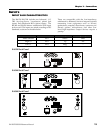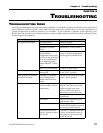
Chapter 3: Operation
RA150/300/500 Reference Manual 21
CHAPTER 3
OPERATION
FRONT PANEL CONTROLS
The following diagram shows the various front
panel controls, as described next.
RA150
RA300
RA500
VOLUME CONTROLS
Detented level controls are on the front panel,
where they can be easily adjusted if necessary.
These regulate the input signal going into the
RA150/300/500. Always turn the volume controls
all the way down (counterclockwise) when making
input or output connections to the RA150/300/500.
Power should be off as well. It’s also good practice
to turn the volume controls all the way down when
turning on power just in case a signal source
feeding the RA150/300/500 is “live.”
ON-OFF SWITCH
Press the switch to turn the amplifier on, and
again to turn the amplifier off.
Upon turning on the amplifier, the power
indicator LED will light. Note that in direct
sunlight, this light may not be easily visible.
When powering a system on or off, it is
usually advisable to turn on the power
amplifiers last and to turn them off
first, so that any turn on or turn off
transient signals generated by other
equipment in the system are not
amplified and sent to the loudspeakers.
However, the RA150/300/500’s output
protection relays have a 4.5 second turn-on delay
which keeps the loudspeakers disconnected
while the system is powering up. These relays
also disconnect the load very quickly when
power is removed from the amplifiers, thus
minimizing the chance that turn-off transients
originating elsewhere in the system will be sent
to the speakers. So, if the RA150/300/500 power
switch is left on and the entire system is powered
up on a single master AC switch, transient
"thumps" should not be a problem.
MUTE SWITCH
Because turning the RA150/300/500 on and off
generates no spikes within the amplifier, the
power switch doubles as a mute switch or “panic
button.” For example, if there is a serious
feedback problem, you can simply turn off the
RA150/300/500, then chase down the source of
the problem.


















